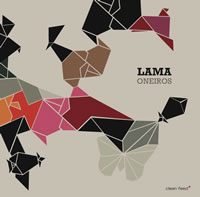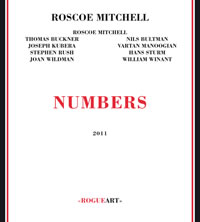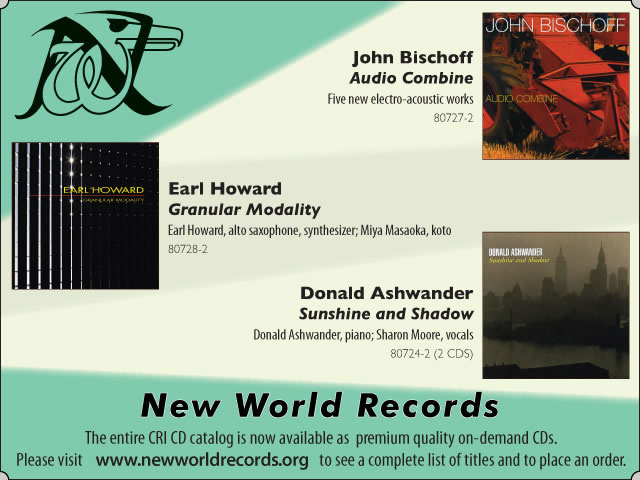Moment's Notice
Reviews of Recent Recordings
(continued)
Lama
Oneiros
Clean Feed CF240CD
 Oneiros is the debut recording by Lama, a Portugal-based trio that grew out of 2008 conservatory studies of bassist Gonçalo Almedia and trumpeter Susana Santos Silva in Rotterdam; there they met Canadian drummer Greg Smith, who was providing percussion accompaniment for a local dance studio. Almedia and Silva were both already established members of the Portuguese improvised music scene, working in Atos and Spinifex Quintet, as well as American ensembles led by Carla Bley, John Hollenbeck, and Lee Konitz. Smith had also worked in the US with David Binney, and abroad with England’s Colonel Red Live and Sandra St. Victor’s Sinner Child.
Oneiros is the debut recording by Lama, a Portugal-based trio that grew out of 2008 conservatory studies of bassist Gonçalo Almedia and trumpeter Susana Santos Silva in Rotterdam; there they met Canadian drummer Greg Smith, who was providing percussion accompaniment for a local dance studio. Almedia and Silva were both already established members of the Portuguese improvised music scene, working in Atos and Spinifex Quintet, as well as American ensembles led by Carla Bley, John Hollenbeck, and Lee Konitz. Smith had also worked in the US with David Binney, and abroad with England’s Colonel Red Live and Sandra St. Victor’s Sinner Child.
“Oneiros” is a Greek noun, meaning “dream.” Lama’s music often seems to alternately erupt and decay in a dream-like fashion, though never evanescently. And like many new generation creative improvisers, Lama embraces technology to this end. Almedia augments his double bass with pedal box-delivered effects, and Silva reconfigures and extends her trumpet and flugelhorn through loops, filters, and effects.
The resulting music is often challenging, but its complexities have clear purpose, particularly in establishing and sustaining mood. Almeida’s lovely “Melodia Minusculeha” has a precious veneer that belies its haunting undertones. An opening pedal point bass figure intermingles with muted trumpet lines suggesting child-like innocence. As Silva’s trumpet fades, the bass becomes more prominent; the trumpet then returns as flutters and soft whirls to reinforce a dream-like ambiance. Throughout the piece, Smith accents such susurrations with mallet rumbles and cymbal shadings. Lama creates contrasting dreamscapes on the Silva-composed “My Fucking Thesis”, where her trumpet is processed to sound at times almost reed-like against driving drums and bass accompaniment, and the opening track, “Alguidar,” which blooms from static scratches that are sustained throughout the song’s swinging tempo and mood shifts.
Oneiros is a solid archetype for future volumes of Lama’s sound-dreams.
–Bobby Hill
Steve Lehman Trio
Dialect Fluorescent
PI Recordings PI42
 On the surface, alto saxophonist Steve Lehman’s Dialect Fluorescent is a rather straight-forward set of originals, garnished with chestnuts like Coltrane’s “Moment’s Notice,” Jackie Mac’s “Mr. E,” and Duke Pearson’s undervalued “Jeannine.” The inclusion of “Pure Imagination” from Willy Wonka & the Chocolate Factory is a cringe-inducing notion (if there’s not already, there should be a circle in Hell where a loop of Gene Wilder and Anthony Newleysinging this inanity plays for eternity); it’s remarkable that Lehman not only negotiates it without drowning in chocolate syrup-like bathos, but manages to buttresses the concept he posits with the album’s title. Dialect becomes fluorescent most noticeably when it creates cognitive consonance; that’s at the heart of the great jazz tradition of quoting tunes mid-solo. Cultural theory didn’t impel Dexter Gordon to quote “Here Comes the Bride” as often as he did – he just knew folks would recognize it and get a kick from it. The jazz artist’s intents and purposes don’t have to be more profound than Gordon’s for dialect to become truly fluorescent.
On the surface, alto saxophonist Steve Lehman’s Dialect Fluorescent is a rather straight-forward set of originals, garnished with chestnuts like Coltrane’s “Moment’s Notice,” Jackie Mac’s “Mr. E,” and Duke Pearson’s undervalued “Jeannine.” The inclusion of “Pure Imagination” from Willy Wonka & the Chocolate Factory is a cringe-inducing notion (if there’s not already, there should be a circle in Hell where a loop of Gene Wilder and Anthony Newleysinging this inanity plays for eternity); it’s remarkable that Lehman not only negotiates it without drowning in chocolate syrup-like bathos, but manages to buttresses the concept he posits with the album’s title. Dialect becomes fluorescent most noticeably when it creates cognitive consonance; that’s at the heart of the great jazz tradition of quoting tunes mid-solo. Cultural theory didn’t impel Dexter Gordon to quote “Here Comes the Bride” as often as he did – he just knew folks would recognize it and get a kick from it. The jazz artist’s intents and purposes don’t have to be more profound than Gordon’s for dialect to become truly fluorescent.
Subsequently, Lehman’s recasting “Pure Imagination” as ecstatic cry comes off as an inspired stroke. Were it not for the well-meshed sound the saxophonist has honed with bassist Matt Brewer and drummer Damion Reid, however, Lehman ran the risk of this piece sticking out like a sore thumb. The combination of Lehman’s expertly shaded sound, which can be feathery one moment and fiery the next, Brewer’s rumbling but well-etched lines, and Reid’s tight snare, an efficient sparkplug for his funk-flecked sense of swing, coheres a wide array of materials. By sanding down the stop-start articulation of Coltrane’s theme, Lehman’s version of “Moment’s Notice” is impressively sleek. Something of the same can be said of “Jeannine;” with the tempo revved up, there’s less of a finger-popping quality to Lehman’s interpretation, but the resulting sprint is invigorating. Lehman ends the album with a rousing toast to his teacher with McLean’s “Mr. E;” the least modified of the covers, it is nevertheless a logical terminus for the ideas Lehman lays out throughout the album.
More often than not on recordings made by Lehman’s contemporaries, there’s an appreciable gap in tone and gravity between covers and original works. That’s not the case on Dialect Fluorescent. Lehman throws some serious curves with his pieces; “Allocentric” and its unaccompanied introduction are built on a slippery Indian-tinged scale, while “Alloy,” “Foster Brothers” and “Fumba Rebel” are each laced with daunting, contrasting rhythms. Yet, there is solid continuity between the two blocks of materials, which is solely attributable to the trio’s chemistry. The music is kept at a simmer for most of the album; it’s a tricky balance, one that Lehman complicates with his penchant for interfacing staccato phrases and streamlined swing. Even though he’s led trios with far more illustrious cohorts, this is the unit that really nails it for Lehman.
–Bill Shoemaker
Roscoe Mitchell
Numbers
RogueArt ROG-0036
 Numbers is devoted to the works of Roscoe Mitchell the composer, a problematic issue for many who question the role of composition in an improviser’s work when it is something more than material to be explored and subsumed in improvisation. While Numbers focuses on through-composition, many of the qualities present in Mitchell’s works for improvisation are present here, albeit with very different senses of containment and limit. These pieces seem to turn back on themselves, rather than outward, developing formal resonances that would be lost in a context that admitted improvisation. The same is true of their interest in sound and resonance. With development controlled absolutely, we experience the most detailed measurement of a sonic relationship.
Numbers is devoted to the works of Roscoe Mitchell the composer, a problematic issue for many who question the role of composition in an improviser’s work when it is something more than material to be explored and subsumed in improvisation. While Numbers focuses on through-composition, many of the qualities present in Mitchell’s works for improvisation are present here, albeit with very different senses of containment and limit. These pieces seem to turn back on themselves, rather than outward, developing formal resonances that would be lost in a context that admitted improvisation. The same is true of their interest in sound and resonance. With development controlled absolutely, we experience the most detailed measurement of a sonic relationship.
The series of works is structured around three solo pieces for bells performed by William Winant. The CD opens with “Bells for New Orleans (prelude)” and ends with “Bells for New Orleans (postlude),” both played on tubular bells: the centerpiece is “Bells for New Orleans,” a more developed work played on orchestral bells that develops near-electronic resonance between ringing adjacent tones. The structure and the pieces lend an overall shape to the CD, their resonance and overtones emphasizing a mood of serious reflection.
Among the pieces played here, there’s a real freedom in Mitchell’s harmonic language, each piece developing its own character and shape as well as a distinctive sound and overtone palette provided by the ever-shifting instruments and players. Several pieces emphasize strings, two with piano. “9/9/99” is an extended duet performed by pianist Joseph Kubera and violinist Vartan Manoogian that demonstrates Mitchell’s particularly dry lyricism. The most effective of the duos is the one on which Mitchell plays with Winant (“WR/C 2A Opus 1”): Mitchell’s sense of voice, conjoined with the permutating overtones and dynamics, makes the piece come most intensely to life. Another highlight is the three-movement piano piece “8/8/88,” a richly varied work that’s performed with both great spirit and attention to detail by Stephen Rush. Emphasizing clusters, it moves in its three movements from solemnity to exuberance. It’s a characteristic movement in Mitchell’s writing, immediately echoed here in “9/9/09,” a powerful solo viola piece performed by Nils Bultman.
The cumulative effect of the pieces is a sense of depth, of resonances developing and continuing, backwards and forwards, within the materials just as they stand.
–Stuart Broomer
Michael Musillami Trio + 4
Mettle
Playscape PSR # 070111
 Michael Musillami founded Playscape Recordings in 1999 in order to regain creative control over his career and provide fellow musicians with a supportive environment for their own efforts. Musillami has since issued over a dozen albums under the imprint as a leader. Although they feature a variety of line-ups, half of the guitarist’s Playscape sessions have been based around his most reliable group – a trio with bassist Joe Fonda and drummer George Schuller – often joined by guest artists. Celebrating ten years performing together, Mettle is their sixth recording as a working unit. Augmented by four of Downtown’s finest improvisers, Musillami’s expanded ensemble interprets a handful of intriguing originals, as well as his first extended suite, the autobiographical eight-part reminiscence, “Summer Suite: Twenty Ten.”
Michael Musillami founded Playscape Recordings in 1999 in order to regain creative control over his career and provide fellow musicians with a supportive environment for their own efforts. Musillami has since issued over a dozen albums under the imprint as a leader. Although they feature a variety of line-ups, half of the guitarist’s Playscape sessions have been based around his most reliable group – a trio with bassist Joe Fonda and drummer George Schuller – often joined by guest artists. Celebrating ten years performing together, Mettle is their sixth recording as a working unit. Augmented by four of Downtown’s finest improvisers, Musillami’s expanded ensemble interprets a handful of intriguing originals, as well as his first extended suite, the autobiographical eight-part reminiscence, “Summer Suite: Twenty Ten.”
Bolstered by the stellar contributions of vibraphonist Matt Moran, trumpeter Russ Johnson and vanguard multi-reedists Jeff Lederer and Ned Rothenberg, Musillami and company embark on a bracing journey through some of the leader’s most captivating compositions. Although blues, bop and swing are omnipresent influences, Musillami’s writing ranges far and wide for stylistic inspiration, which includes distinctive interludes subtly informed by everything from tango (“Piazzolla On The Porch”) to hip-hop (“Thuggish Mornings”).
Musillami continues to explore the use of EFX like chorus, distortion and reverb, amplifying the septet’s rich color palette, as he did on 2009’s From Seeds – the first documented example of Musillami’s use of EFX on record. This date expands upon the earlier session’s developments (which coincidentally featured a similar line-up), presenting the former purist using his new set-up with tasteful restraint. Generating an array of vivid hues, he introduces the atmospheric set opener “Piano Del Greci” with an extended salvo of coruscating notes, ably supported by the rhythm section’s subtle accents. Veering from brusque staccato fragments to searing legato tones, his prismatic cadences set the stage for a series of pithy trades between the horns and Moran, introducing each soloist in turn.
Gracefully sequenced, the extended “Summer Suite: Twenty Ten” is bookended by two long-form compositions – “Blues For The Wounded Warrior,” a muscular avant-garde blues ode to veterans, and the labyrinthine swinger “Thuggish Mornings,” a wry musical commentary on a private family joke. Similarly inspired by familial camaraderie are “High Likeability Factor” and “Moe,” transitional cadenzas of the main suite that spotlight Fonda and Schuller’s respective virtuosity as unaccompanied soloists, as well as their longstanding relationship with the leader.
The remainder of the suite encapsulates dynamic group interplay reinforced by ardent individual solos, beginning with the first movement, “Iceland,” a sonic tone poem that captures the ominous tension and grandiose fury of the Icelandic volcano Eyjafjallajökull, which erupted in 2010 while Musillami was touring abroad. Musillami unveils his dynamic range on this episodic number with a pair of contrasting statements; his gnarled, histrionic fretwork at the outset is offset by a far more measured excursion filled with sophisticated harmonic detours and coy lyrical motifs towards the coda. Subsequent genre-specific forays provide ample evidence of his bandmate’s interpretive prowess, including Lederer’s bristling free-bop evocation of urban living (“Liv’s In Beantown”) and Johnson’s affinity for winsome Americana (“Nebraska”). The suite climaxes with the rapturous “Barnstable News,” ending on a fervently optimistic note that encapsulates the underlying mood of this appropriately titled release.
–Troy Collins
